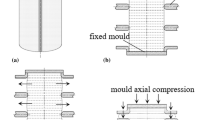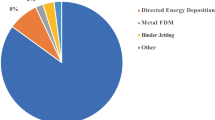Abstract
This paper aims to develop a new forming technique to manufacture a long semihollow stepped part. Traditionally, hot backward extrusion is used, but this technique is not suitable because it requires a very high forming load to act on the die and punch, especially at the contact between the punch and workpiece. As a result, the service life of the punch is very low. Therefore, a new technique to overcome this problem is needed. A combined bulging–piercing technique was proposed and developed in this research. The main concept of this technique is to bulge the part by upsetting the workpiece between the punch and counterpunch to generate high frictional contact pressure, which will help to restrain the material from sliding down into the die cavity during the piercing step. In other words, this technique utilizes frictional force at the die–workpiece interface to reduce the forming load of the punch. Finite element modeling was employed to investigate and determine a suitable level of the bulging which can reduce the forming load without generating any significantly high force to the counterpunch. Only experiments with the minimum forming load were selected and implemented to validate this concept because other conditions with high load will risk damaging the punch and machine press of the product line. The results show that this technique can reduce the forming load by almost 40% and also control a good concentricity of the part and reduce the wall thickness variation.






























Similar content being viewed by others
Availability of data and material
The authors confirm that the data supporting the findings of this study are available within the article and/or its supplementary materials.
Code availability
Not applicable.
References
Politis DJ, Politis NJ, Lin J, Dean TA (2018) A review of force reduction methods in precision forging axisymmetric shapes. Int J Adv Manuf Technol 97:2809–2833. https://doi.org/10.1007/s00170-018-2151-2
Kondo K, Jitsunari T, Ohga K (1985) Investigations on Cold Die Forging of a Gear Utilizing Divided Flow: 1st Report, Examination of applicable condition for a spur gear. Bull JSME 28(244):2442–2450
Kondo K, Ohga K (1995) Precision cold die forging of a ring gear by divided flow method. Int J Mach Tools Manuf 35(8):1105–1113. https://doi.org/10.1016/0890-6955(95)90405-B
Nakano T (1994) Modern applications of complex forming and multi-action forming in cold forging. J Mater Process Technol 46(1–2):201–226. https://doi.org/10.1016/0924-0136(94)90111-2
Merklein M, Allwood JM, Behrens BA, Brosius A, Hagenah H, Kuzman K, Weckenmann A (2012) Bulk forming of sheet metal. CIRP Ann Manuf Technol 61(2):725–745. https://doi.org/10.1016/j.cirp.2012.05.007
Merklein M, Koch J, Opel S, Schneider T (2011) Fundamental investigations on the material flow at combined sheet and bulk metal forming processes. CIRP Ann Manuf Technol 60(1):283–286. https://doi.org/10.1016/j.cirp.2011.03.146
Nakeenopakun N, Aue-u-lan Y (2020) A proposed Common Single-Die Exchange Technique (C-SDET) to enhance production of pulleys. Int J Adv Manuf Technol 107(9):3625–3643. https://doi.org/10.1007/s00170-020-05267-0
Shao Y, Lu B, Ou H, Ren F, Chen J (2014) Evolutionary forging preform design optimization using strain-based criterion. Int J Adv Manuf Technol 71(1):69–80. https://doi.org/10.1007/s00170-013-5456-1
Park JJ, Rebelo N, Kobayashi S (1983) A new approach to preform design in metal forming with the finite element method. Int J Mach Tools Manuf 23(1):71–79. https://doi.org/10.1016/0020-7357(83)90008-2
Zhao G, Ma X, Zhao X, Grandhi RV (2004) Studies on optimization of metal forming processes using sensitivity analysis methods. J Mater Process Technol 147(2):217–228. https://doi.org/10.1016/j.jmatprotec.2003.12.018
Schmieder F, Kettner P (1997) Manufacturing of hollow transmission shafts via bulk-metal forging. J Mater Process Technol 71(1):113–118. https://doi.org/10.1016/S0924-0136(97)00156-8
GmbH SCHULER (1998) Metal Forming Handbook. Springer-Verlag, Berlin, Heidelberg
Handbook ASM (2005) Metalworking: bulk forming, vol 14A. ASM International, Metal Park, OH, USA
Saiki H, Marumo Y, Minami A, Sonoi T (2001) Effect of the surface structure on the resistance to plastic deformation of a hot forging tool. J Mater Process Technol 113(1–3):22–27. https://doi.org/10.1016/S0924-0136(01)00632-X
Abrinia K, Gharibi K (2008) An investigation into the backward extrusion of thin walled cans. Int J Mater Form 1:411–414. https://doi.org/10.1007/s12289-008-0082-4
Danckert J (2004) The influence of the punch land in backward can extrusion. CIRP Ann Manuf Technol 53(1):227–230. https://doi.org/10.1016/S0007-8506(07)60685-4
Long H (2006) Quantitative evaluation of dimensional errors of formed components. J Mater Process Technol 177(1–3):591–595. https://doi.org/10.1016/j.jmatprotec.2006.04.079
Labanova N, Liewald M, Felde A (2015) Production of extremely deep sleeves by backward cold extrusion. In MATEC Web of Conferences. EDP Sciences 21:2008. https://doi.org/10.1051/matecconf/20152102008
Jeong DJ, Kim DJ, Kim JH, Kim BM, Dean TA (2001) Effects of surface treatments and lubricants for warm forging die life. J Mater Process Technol 113(1–3):544–550. https://doi.org/10.1016/S0924-0136(01)00693-8
DEFORM V10.0.2 Manual (2010), Scientific Forming Technologies Corporation, OH, USA
Handbook ASM (1993) Forming and Forging, vol 14. ASM international, Metal Park, OH, USA
Funding
The authors declare that no funds, grants, or other support were received during the preparations of this manuscript.
Author information
Authors and Affiliations
Contributions
Not applicable.
Corresponding author
Ethics declarations
Ethics approval
Not applicable.
Consent to participate
Not applicable.
Consent for publication
Not applicable.
Competing interests
The authors declare no competing interests.
Additional information
Publisher's note
Springer Nature remains neutral with regard to jurisdictional claims in published maps and institutional affiliations.
Rights and permissions
About this article
Cite this article
Nakeenopakun, N., Olarnrithinun, S. & Aue-u-lan, Y. Development of a combined bulging-piercing technique to reduce forming load for a long semihollow stepped part. Int J Adv Manuf Technol 121, 2063–2082 (2022). https://doi.org/10.1007/s00170-022-09480-x
Received:
Accepted:
Published:
Issue Date:
DOI: https://doi.org/10.1007/s00170-022-09480-x




